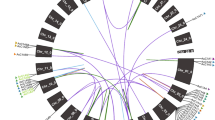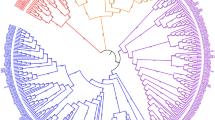Abstract
Pineapple, Ananas comosus, is an economically important fruit crop. Recently its genome was completely sequenced and a total of 27,024 protein coding genes were predicted. Using a set of well evaluated bioinformatics tools we have predicted the protein subcellular locations and comparatively analyzed the protein conserved domains of the predicted proteomes in pineapple, Oryza sativa (rice), Sorghum bicolor (sorghum), and Brachypodium distachyson. Our analysis revealed that ~24–26 % of proteins were located in nucleus, 17–21 % in cytosol, 9–11 % in chloroplast, and 8–11 % proteins were secreted in these monocot plants. The secretomes in the four species were analyzed comparatively and a large number of secreted glycosyl hydrolases were identified. As pineapple proteolytic enzymes, knowns as bromelains, have been used for medical treatments, we focused on genome-wide identification and analysis of pineapple genes encoding proteases. A total of 512 pineapple genes encoding putative proteolytic enzymes were identified, with 152 secreted, 74 localized in cytosol, 67 in nucleus, 60 in chloroplast, 18 in mitochondria, and the remaining in other subcellular locations. The top large protease families in pineapple were papain family cysteine protease (62 genes), peptidase S8 family (56 genes), aspartyl protease family (38 genes), and serine carboxypeptidase (33 genes). Gene expression analysis revealed that among 512 protease genes 432 were expressed in various tissues and 72 genes were differentially expressed. The highly expressed protease genes were identified including 7 papain family cysteine proteases. The protease genes with the predicted protein subcellular locations will facilitate the efforts for examining their biological roles in pineapple growth and development and for expressing the recombinant proteases for medical use. The information of protein subcellular location of all plant species can be accessed at the PlantSecKB website (http://proteomics.ysu.edu/secretomes/plant.php).
Similar content being viewed by others
Abbreviations
- BLAST:
-
basic local alignment search tool.
- ER:
-
endoplasmic reticulum.
- GO:
-
Gene ontology.
- FPKM:
-
Fragments Per Kilobase exon per Million reads mapped.
- rpsBLAST:
-
reversed position specific BLAST.
References
Agrawal GK, Jwa NS, Lebrun MH, Job D, Rakwal R (2010) Plant secretome: unlocking secrets of the secreted proteins. Proteomics 10:799–827
Amid A, Ismail NA, Yusof F, Salleh HM (2011) Expression, purification, and characterization of a recombinant stem bromelain from Ananas comosus. Process Biochem 46:2232–2239
Arshad ZIM, Amid A, Yusof F et al (2014) Bromelain: an overview of industrial application and purification strategies. Appl Microbiol Biotechnol 98:7283–7297
Barrett AJ, McDonald JK (1986) Nomenclature: protease, proteinase and peptidase. Biochem J 237:935
Bartholomew DP, Kadzimin SB (1977) Pineapple. In: Alvin PT, Kozeowski TT (eds) Ecophysiology of tropical crops. Academic, New York, NY, pp 113–156
Bartholomew DP, Malézieux EP (1994) Pineapple. In: Schaffer B, Andersen PC (eds) Handbook of environmental physiology of fruit crops, vol 2. CRC Press, Boca Raton, pp 243–291
Carter CE, Marriage H, Goodenough PW (2000) Mutagenesis and kinetic studies of a plant cysteine proteinase with an unusual arrangement of acidic amino acids in and around the active site. Biochemistry 39:11005–11013
de Lencastre Novaes LC, Jozala AF, Lopes AM et al (2016) Stability, purification, and applications of bromelain: a review. Biotechnol Prog 32:5–13. doi:10.1002/btpr.2190
Emanuelsson O, Brunak S, von Heijne G, Nielsen H (2007) Locating proteins in the cell using TargetP, SignalP and related tools. Nat Protoc 2:953–971
George S, Bhasker S, Madhav H, Nair A, Chinnamma M (2014) Functional characterization of recombinant bromelain of Ananas comosus expressed in a erokaryotic system. Mol Biotechnol 56:166–174
González-Rábade N, Badillo-Corona JA, Aranda-Barradas JS, del Carmen O-SM (2011) Production of plant proteases in vivo and in vitro—a review. Biotechnol Adv 29:983–996
Habib H, Fazili KM (2007) Plant protease inhibitors: a defense strategy in plants. Biotechnol Mol Biol Rev 2:68–85
Heinicke RM, Gortner WA (1957) Stem bromelain - a new protease preparation from pineapple plants. Econ Bot 11:225–234
Horton P, Park K-J, Obayashi T et al (2007) WoLF PSORT: protein localization predictor. Nucleic Acids Res 35:585–587
Isaacson T, Rose JKC (2006) The plant cell wall proteome, or secretome. In: Finnie C (ed) Plant Proteomics. Annual Plant Reviews Series. Blackwell Publishing 28:185–209
Jung YJ, Choi CS, Park JH et al (2008) Overexpression of the pineapple fruit bromelain gene (BAA) in transgenic Chinese cabbage (Brassica rapa) results in enhanced resistance to bacterial soft rot. Electron J Biotechnol 11:71–79
Käll L, Krogh A, Sonnhammer EL (2004) A combined transmembrane topology and signal peptide prediction method. J Mol Biol 338:1027–1036
Krogh A, Larsson B, von Heijne G, Sonnhammer ELL (2001) Predicting transmembrane protein topology with a hidden Markov model: application to complete genomes. J Mol Biol 305:567–580
Lee KL, Albee KL, Bernasconi RJ, Edmunds T (1997) Complete amino acid sequence of ananain and a comparison with stem bromelain and other plant cysteine proteases. Biochem J 327(Pt 1):199–202
Lopez-Casado G, Urbanowicz BR, Damasceno CM, Rose JK (2008) Plant glycosyl hydrolases and biofuels: a natural marriage. Curr Opin Plant Biol 11:329–337
López‐García B, Hernández M, Segundo BS (2012) Bromelain, a cysteine protease from pineapple (Ananas comosus) stem, is an inhibitor of fungal plant pathogens. Lett Appl Microbiol 55:62–67
Lum G, Min XJ (2011) Plant secretomes: current status and future perspectives. Plant Omics 4:114–119
Lum G, Min XJ (2013) Bioinformatic protocols and the knowledge-base for secretomes in fungi. In: Gupta VK, Tuohy MG, Ayyachamy M, Turner KM, O’Donovan A (eds) Laboratory protocols in fungal biology: current methods in fungal biology, Springer pp 545–557.
Lum G, Vanburen R, Ming R, Min XJ (2013) Secretome prediction and analysis in sacred lotus (Nelumbo nucifera Gaertn.). Trop Plant Biol 6:131–137
Lum G, Meinken J, Orr J, Frazier S, Min XJ (2014) PlantSecKB: the plant secretome and subcellular proteome knowledgebase. Computat Mol Biol 4(1):1–17
Marchler-Bauer A, Derbyshire MK, Gonzales NR et al (2015) CDD: NCBI’s conserved domain database. Nucleic Acids Res 43:222–226
McCarthy FM, Wang N, Magee GB et al (2006) AgBase: a functional genomics resource for agriculture. BMC Genomics 7:229
Meinken J, Min XJ (2012) Computational prediction of protein subcellular locations in eukaryotes: an experience report. Comput Mol Biol 2(1):1–7. doi:10.5376/cmb.2012.02.0001
Meiser P, Xu Z, Kirsch G, Jacob C (2014) Systemic enzyme therapy: fact or fiction? a review with focus on bromelains, proteolytic enzymes from the pineapple plant. In: Recent Advances in Redox Active Plant and Microbial Products. Springer Netherlands. p 449–467
Min XJ (2010) Evaluation of computational methods for secreted protein prediction in different eukaryotes. J Proteomics Bioinfo 4:143–147
Ming R, VanBuren R, Wai CM et al (2015) The pineapple genome and the evolution of CAM photosynthesis. Nat Genet 47:1435–1442. doi:10.1038/ng.3435
Neuteboom LW, Matsumoto KO, Christopher DA (2009) An extended AE-rich N-terminal trunk in secreted pineapple cystatin enhances inhibition of fruit bromelain and is posttranslationally removed during ripening. Plant Physiol 151:515–527
Pavan R, Jain S, Kumar A (2012) Properties and therapeutic application of bromelain: a review. Biotechnol Res Int. doi:10.1155/2012/976203
Petersen TN, Brunak S, von Heijne G, Nielsen H (2011) SignalP 4.0: discriminating signal peptides from transmembrane regions. Nat Methods 8:785–786
Raimbault AK, Zuily-Fodil Y, Soler A et al (2013a) The expression patterns of bromelain and AcCYS1 correlate with blackheart resistance in pineapple fruits submitted to postharvest chilling stress. J Plant Physiol 170:1442–1426
Raimbault AK, Zuily-Fodil Y, Soler A, de Carvalho MHC (2013b) A novel aspartic acid protease gene from pineapple fruit (Ananas comosus): cloning, characterization and relation to postharvest chilling stress resistance. J Plant Physiol 170:1536–1540
Sigrist CJA, Cerutti L, de Casro E et al (2010) PROSITE, a protein domain database for functional characterization and annotation. Nucleic Acids Res 38:161–166
Taussig SJ, Batkin S (1988) Bromelain, the enzyme complex of pineapple (Ananas comosus) and its clinical application: an update. J Ethnopharmacol 22:191–203
Tran HT, Plaxton WC (2008) Proteomic analysis of alterations in the secretome of Arabidopsis thaliana suspension cells subjected to nutritional phosphate deficiency. Proteomics 8:4317–4326
Trapnell C, Roberts A, Goff L et al (2012) Differential gene and transcript expression analysis of RNA-seq experiments with TopHat and Cufflinks. Nat Protoc 7:562–578
UniProt Consortium (2015) UniProt: a hub for protein information. Nucleic Acids Res 43:204–212. doi:10.1093/nar/gku989
van der Biezen EA, Jones JD (1998) The NB-ARC domain: a novel signalling motif shared by plant resistance gene products and regulators of cell death in animals. Curr Biol 8:226–227
van der Hoorn RA (2008) Plant proteases: from phenotypes to molecular mechanisms. Annu Rev Plant Biol 59:191–223
van Wijk KJ (2015) Protein maturation and proteolysis in plant plastids, mitochondria, and peroxisomes. Annu Rev Plant Biol 66:75–111
Wai CM, Powell B, Ming R, Min XJ (2016) Analysis of alternative splicing landscape in pineapple (Ananas comosus). Tropical Plant Biol. doi:10.1007/s12042-016-9168-1
Wang W, Zhang L, Guo N et al (2014) Functional properties of a cysteine proteinase from pineapple fruit with improved resistance to fungal pathogens in Arabidopsis thaliana. Molecules 19:2374–2389
Acknowledgments
The work was supported by the University of Illinois at Urbana-Champaign to RM and Youngstown State University (YSU) Research Council to XJM.
Author information
Authors and Affiliations
Corresponding author
Additional information
Communicated by: Paulo Arruda
Electronic Supplementary Material
Below is the link to the electronic supplementary material.
Supplementary Table 1
Gene Ontology classification of proteomes in four monocot plants (XLSX 17 kb)
Supplementary Table 2
Protein family and conserved domain distribution in different plants (XLSX 404 kb)
Supplementary Table 3
Summary of conserved protein domain families in the secretomes of different plants (XLSX 87 kb)
Supplementary Table 4
Protease family including secreted protein family distribution in different plants (XLSX 23 kb)
Supplementary Table 5
Putative proteolytic enzymes with their subcellular locations (XLSX 29 kb)
Supplementary Table 6
Differentially expressed genes in ripening fruits of pineapple (XLSX 62 kb)
Supplementary Table 7
Gene expression of pineapple protease coding genes (XLSX 29 kb)
Rights and permissions
About this article
Cite this article
Wai, C.M., Powell, B., Ming, R. et al. Genome-Wide Identification and Analysis of Genes Encoding Proteolytic Enzymes in Pineapple. Tropical Plant Biol. 9, 161–175 (2016). https://doi.org/10.1007/s12042-016-9172-5
Received:
Accepted:
Published:
Issue Date:
DOI: https://doi.org/10.1007/s12042-016-9172-5




